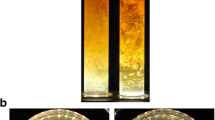Abstract
The large bowel intestinal flora of mammals is made up mostly of O2-intolerant anaerobic microorganisms which are irreversibly damaged by brief exposure to air. The aim of our work was to investigate the effect of atmospheric O2 on human intestinal anaerobic microorganisms. Thirty O2-intolerant bacterial strains that reached 100% mortality after 120 min of air exposure were isolated. Ten of these strains were tested for their atmospheric O2 sensitivity as a function of air exposure time; all tested microorganisms showed a similar mortality trend on exposure to air. In fact, 50% of cells survive, on the average, after 4–5 min of atmospheric O2; this percentage decreases to 3–5% after only 20 min, and after 40 min only one cell in a thousand survives; all strains reached 100% mortality in a time range of 100–120 min. The strains examined were identified as belonging to the generaEubacterium, Peptostreptococcus, andCoprococcus.
Similar content being viewed by others
Literature Cited
Aranki A, Freiter R (1972) Use of anaerobic glove boxes for the cultivation of strictly anaerobic bacteria. Am J Clin Nutr 25:1329–1334
Aranki A, Syed SA, Kennedy EB, Freiter R (1969) Isolation of anaerobic bacteria from human gingiva and mouse cecum by means of a simplified glove box procedure. Appl Microbiol 17:568–576
Brusa T, Ferrari A (1986) Studi atti a migliorare i livelli di anossia durante le manipolazioni microbiologiche in cabina anaerobica e modifiche strutturali dell'apparecchiatura. Ann Microbiol Enzimol 36:85–90
Carlsson J, Nyberg G, Wrethen J (1978) Hydrogen peroxide and superoxide radical formation in anaerobic broth media exposed to atmospheric oxygen. Appl Environ Microbiol 36:223–229
Drasar BS (1967) Cultivation of anaerobic intestinal bacteria. J Pathol Bacteriol 94:417–427
Ferrari A, Pacini N, Canzi E, Bruno F (1980) Presence of oxygen intolerant microorganisms in primary bile acid 7-dehydroxylating mouse intestinal microflora. Curr Microbiol 4:257–260
Fesce A (1973) La flora microbica intestinale. Folia Vet Latina 3:635–652
Fesce A, Ceccarelli A, Poli G, Balsari A, Giovannini R (1977) Metodo per l'isolamento e lo studio di batteri anaerobici ossigeno intolleranti. Arch Vet Ital 28:1–9
Finegold SM, Sutter VL, Mathisen GE (1983) Normal indigenous intestinal flora. In: Hentges DS (ed) Human intestinal flora in health and disease. New York: Academic Press, pp 3–31
Fredette V, Planté C, Roy A (1967) Numerical data concerning the sensitivity of anaerobic bacteria to oxygen. J Bacteriol 93:2012–2017
Fridovich I (1983) Superoxide radical an endogenous toxicant. Annu Rev Pharmacol Toxicol 23:239–257
Gregory EM, Moore WEC, Holdeman LV (1978) Superoxide dismutase in anaerobes: survey. Appl Environ Microbiol 35:988–991
Gustafsson BE (1982) The physiological importance of the colonic microflora. Scand J Gastroenterol 17/77:117–131
Hassan HM, Fridovich I (1980) Superoxide dismutase: detoxication of a free radical. In: Jakoby WB (ed) Enzymatic basis of detoxication, vol 1. New York: Academic Press, pp 311–332
Holdeman LV, Moore WEC (1973) Anaerobic laboratory manual, 4th edn. Blaksburg, VA: Virginia Polytechnic Institute and State University Anaerobe Laboratory.
Hungate RE (1950) The anaerobic mesophilic cellulolytic bacteria. Bacteriol Rev 14:1–49
Kikuchi HE, Suzuki T (1986) Quantitative method for measurement of aerotolerance of bacteria and its application to oral indigenous anaerobes. Appl Environ Microbiol 52:971–973
Loesche WJ (1969) Oxygen sensitivity of various anaerobic bacteria. Appl Microbiol 18:723–727
Mevissen-Verhage EAE, De Vos NM, Harmsen van Amerongen WCM, Marcelis JH (1982) A selective medium for the detection and enumeration of clostridia in human facces. Antonie van Leeuwenhoek 48:205–206
Moore WHC (1966) Techniques for routine culture of fastidious anaerobes. Int J Syst Bacteriol 16:173–190
Morris JG (1976) Oxygen and the obligate anaerobe. J Appl Bacteriol 40:229–244
Onderdonk AB, Johnston J, Mayhew JW, Gorback SL (1976) Effect of dissolved oxygen on Eh onBacteroides fragilis during continuous culture. Appl Environ Microbiol 31:168–172
Patel GB, Roth LA, Agnew BJ (1984) Death rates of obligate anaerobes exposed to oxygen and the effect of media prereduction on cell viability. Can J Microbiol 30:228–235
Rolfe RO, Hentges DJ, Barrett TT, Campbell BJ (1977) Oxygen tolerance of human intestinal anaerobes. Am J Clin Nutr 30:1762–1769
Rolfe RO, Hentges DJ, Campbell BJ, Barrett TT (1978) Factors related to the oxygen tolerance of anaerobic bacteria. Appl Environ Microbiol 36:306–313
Samah OA, Wimpenny JWT (1982) Some effects of oxygen on the physiology ofSelenomonas ruminantium WPL 151/1 growth in continuous culture. J Gen Microbiol 128:335–360
Schwartz AC (1973) Anaerobiosis and oxygen consumption of some strains ofPropionibacterium and a modified method for comparing the oxygen sensitivity of various anaerobes. Z Allg Mikrobiol 13:681–691
Sneath PHA, Mair NS, Sharpe ME, Holt JG (1986) Bergey's manual of systematic bacteriology, 1st ed. Baltimore, London, Los Angeles: Williams & Wilkins
Tally FP, Stewart PR, Sutter VR, Rosemblatt JE (1975) Oxygen tolerance of fresh clinical anaerobic bacteria. J Clin Microbiol 1:161–164
Author information
Authors and Affiliations
Rights and permissions
About this article
Cite this article
Brusa, T., Canzi, E., Pacini, N. et al. Oxygen tolerance of anaerobic bacteria isolated from human feces. Current Microbiology 19, 39–43 (1989). https://doi.org/10.1007/BF01568901
Issue Date:
DOI: https://doi.org/10.1007/BF01568901




